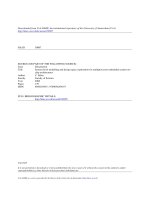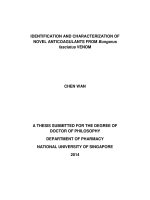Modeling and characterization of on chip interconnects, inductors and transformers
Bạn đang xem bản rút gọn của tài liệu. Xem và tải ngay bản đầy đủ của tài liệu tại đây (1.86 MB, 175 trang )
MODELING AND CHARACTERIZATION OF ON-CHIP
INTERCONNECTS, INDUCTORS AND TRANSFORMERS
KAI KANG
NATIONAL UNIVERSITY OF SINGAPORE
AND
ÉCOLE SUPÉRIEURE D’ÉLECTRICITÉ
2008
MODELING AND CHARACTERIZATION OF ON-CHIP
INTERCONNECTS, INDUCTORS AND TRANSFORMERS
KAI KANG
(B. Eng., Northwestern Polytechnical University, P. R. China)
A THESIS SUBMITTED
FOR THE JOINT DEGREE OF DOCTOR OF PHILOSOPHY
DEPARTMENT OF ELECTRICAL & COMPUTER ENGINEERING
NATIONAL UNIVERSITY OF SINGAPORE AND
ÉCOLE SUPÉRIEURE D’ÉLECTRICITÉ
2008
II
Acknowledgements
This part of the thesis is probably the hardest to write. It is very difficult for me to find the
words conveying the sincerity and magnitude of my gratitude to those who make this thesis
possible through their significant supports and encouragements. First and foremost, I would
like to thank Prof. Li Le-Wei, my principal thesis supervisor. I really appreciate that he offered
me this great opportunity to study in his group at NUS. His kind decision definitely opens a new
era of my life. I am grateful to him for creating this particularly stress-free environment which
provides a large degree of freedom for me to enjoy my studies and research work. Throughout
my time at NUS, I have been repeatedly surprised by the depth and breadth of his knowledge in
all aspects of electrical engineering and his instincts for research and development for RF &
microwave industries. He also always shares his valuable experiences and his intellectual
maturity with me which are undoubtedly useful to my future career.
I would also like to thank Prof. Saïd Zouhdi, who offered me the great opportunity to
explore French culture and study for a year in Paris, the most beautiful city in the world.
Without his support and advice, my studies at Supélec and LGEP could not be so fruitful. I
would also like to thank Prof. Yin Wen-Yan at Shanghai Jiao-tong University, China. It was his
vision and encouragement that first led me to investigate the modeling of on-chip passive
components and consider the new ideas that eventually led to this thesis. He provides not only
invaluable advice but also role model for me to explore the unknown scientific world with great
interests and perseverance during my graduate studies and even my entire life. I am grateful to
his patience and guidance throughout these years. Special thanks to Dr. Koen Mouthaan for his
valuable discussion and funding support to the test structures fabrication. He has been
III
exceptionally helpful in my stay at NUS, during which his door has always been open for me.
Prof. Yeo Tat-Soon has given me a lot of invaluable feedback on my research and has been very
generous with his time on my qualify exam committee.
I would also like to thank all of the helpful people I have encountered while working at
Institute of Microelectronics. First, I would like to thank Dr. Shi Jinglin, who has given me
invaluable advice and help on test structures designs and measurements. Furthermore, I would
like to thank Dr. Subhash C. Rustagi, who gave me the chance to work on a project that would
help direct my graduate studies. His experiences and advice regarding compact modeling and
composing technical papers were very helpful to my research. I am also grateful to other staff at
IME: Dr. James Brinkhoff, Dr. Lin Fujiang, Dr. Zheng Yuanjin, Dr. Xiong Yong-Zhong and Dr.
Sun Sheng.
I have been very lucky to work in a research group with many extraordinarily outstanding
students. I am deeply grateful for the help, encouragement and collaboration of Qiu Cheng-Wei,
Fei Ting, Yuan Tao, Zhang Lei, Feng Zhuo, Xu Wei, Nan Lan, Gao Yuan, Zhao Guang, Fan
Yijin, Li Yanan, She Hao-Yuan and many others. I am also grateful to Dr. Yao Hai-Yin, Dr. Xin
Hong, Dr. Zhang Min, Dr. Zhao Weijiang, Dr. Yuan Ning and Dr. Nie Xiaochun for their
valuable help and friendship. Special thanks to Mr. Jack Ng for keeping the computer systems
up and running. I would like to extend my appreciation to former members of Li group: Dr. Sun
Jin, Mr. Pan Shu-Jun, Dr. Liu En-Xiao and many others.
My friends at and outside NUS have provided important recreational and emotional support
throughout the years: He Li, Dr. Chen Jianfeng, Shi Shaomei, Dr. Guo Rui, Dr. Wang Qiuhong,
Li Ling, Wang Yadong, Zhang Tianxia, Dr. Ren Chi, Zhang Li, Darwin Chai, Liu Xiaofeng, Wu
Man, Guo Minxuan, Yuan Yin, Dong Yang and many others. I will fondly remember all those
IV
dinner gatherings, parties and trips during holidays.
Last, but not certainly not least, I would like to thank all my family members for their love,
support and constant encouragement in the long course of my study. I am very grateful to my
parents in-law for treating me as their own son and for providing the much needed support. I
would like to thank my mother and my father who have been there throughout my life and
love me unconditionally despite all my failings. One really could not ask for more and I
eternally indebted to them. And lastly, I offer my dearest thanks to my wife, Jing, to whom I
owe this degree most to. Her constant love, support, kindness and funniness helped me to
always keep my perspective and enjoy what I was doing.
V
Table of Contents
ACKNOWLEDGEMENTS II
TABLE OF CONTENTS V
SUMMARY VIII
LIST OF TABLES IX
LIST OF FIGURES X
CHAPTER 1. INTRODUCTION 1
1.1 On-Chip Interconnects 1
1.1.1 Background 1
1.1.2 Motivation 3
1.2 On-Chip Inductors and Transformers 6
1.2.1 Background 6
1.2.2 Motivation 8
1.3 Thesis Organization 9
1.4 Original Contributions 10
1.5 Publication List 14
CHAPTER 2. MODELING OF ON-CHIP SINGLE INTERCONNECT 18
2.1 Introduction 18
2.2 A Wideband Scalable and SPICE-Compatible Model 20
2.2.1 Skin Effect 21
2.2.2 Proximity and Substrate Skin Effects 23
2.2.3 Substrate Skin Effect and Complex Image Method 26
2.2.4 Model Set-up 33
2.3 Effect of Dummy Metal Fills 35
2.4 Empirical Formulas for Elements in Series Branch 36
2.5 Measurements and De-embedding 38
2.6 Experimental Results and Model Validation 40
2.7 Summary 45
CHAPTER 3. CHARACTERIZATION OF ON-CHIP COUPLED
(A)SYMMETRICAL INTERCONNECTS 46
VI
3.1 Introduction 47
3.2 Coupled On-Chip Interconnects 48
3.3 Distributed Parameters and Propagation Constants 51
3.3.1 Resistances and Inductances 52
3.3.2 Capacitances and Conductances 55
3.3.3 Propagation Constants 63
3.3.4 Slow-wave Factors 68
3.4 Pulse Responses 70
3.5 Average Power Handling Capabilities (APHC) 75
3.6 Test Structure Fabrication and Measurements 80
3.7 Experimental Results and Discussions 81
3.8 Summary 84
CHAPTER 4. MODELING AND DESIGN OF ON-CHIP INDUCTORS 86
4.1 Introduction 87
4.2 Greenhouse Method Incorporating with CIM Technique 89
4.3 Temperature-Dependent Substrate Conductivity 93
4.4 Eleven-Element Equivalent Circuit Model of On-chip Inductors 94
4.5 Results and Discussions 95
4.5.1 Square Spiral Inductor 95
4.5.1.1 Variations in the Substrate Conductivity………………………………98
4.5.1.2 Temperature Effects………………………………………………… 101
4.5.2
Differential Inductor 103
4.6 Design of A Vertical Tapered Solenoidal Inductor 105
4.6.1 Theory and Formulation 106
4.6.2 Layout 107
4.6.3 Measurement Results and Discussions 109
4.7 Summary 111
CHAPTER 5. FREQUENCY-THERMAL CHARACTERIZATION OF ON-CHIP
TRANSFORMERS WITH PATTERNED GROUND SHIELDS 113
5.1 Introduction 114
5.2 Geometries of On-Chip PGS Transformers 116
5.3 Modified Temperature-Dependent Equivalent-Circuit Models 117
5.3.1 Equivalent Circuit Model for an Interleaved Transformer 117
VII
5.3.2 Equivalent Circuit Model for a Center-tapped Interleaved Transformer 122
5.3.3 Temperature Effects 124
5.4 Fabrication and Measurements 132
5.5 Extraction of Performance Parameters and Discussion 133
5.5.1 Maximum Available Gain (G
max
) 133
5.5.2 Q Factor 137
5.5.3 Power Loss 139
5.6 Summary 140
CHAPTER 6. CONCLUSIONS 141
6.1 Summary 141
6.2 Future Work 144
BIBLIOGRAPHY 145
VIII
Summary
In today’s semiconductor industries, the mask cost increases dramatically, which makes
the cost of a re-design more significant. On the other hand, on-chip passive components such
as interconnects, inductors and transformers are widely used in high speed digital,
mixed-signal and radio frequency integrated circuits (ICs). Therefore, accurate modeling of
circuit behavior, especially for these passive components, is crucial for first-time-right
designs.
This research focus on modeling and characterization of on-chip interconnects, inductors
and transformers. Firstly, a fully scalable and SPICE-compatible interconnects model is
established and this model is accurate over a wideband frequency range from DC up to 110
GHz which has been verified by using measured S-parameters. In addition, this model also
shows the capability to estimate the impact of metal dummy fills. Secondly, frequency- and
temperature-dependent characteristics of on-chip coupled asymmetrical and symmetrical
interconnects are investigated in detail, and a model for coupled interconnects is established
and compared with experimental results.
Furthermore, an eleven-element equivalent circuit model is established for simulating
on-chip spiral inductors. The substrate skin effect is correctly characterized by this model.
Additionally, a vertical tapered solenoidal inductor is designed to achieve a high resonance
frequency. Finally, extensive studies on the performances of on-chip transformers with and
without patterned ground shields at different temperatures are carried out. These transformers
are fabricated using 0.18-μm RF CMOS processes and are designed to have either interleaved
or center-tapped interleave geometries, respectively.
IX
List of Tables
Table 2.1 The Coefficients of Empirical Formulas for the Elements in Series Branch of the Proposed
Model 37
Table 2.2 The Values of Lumped Elements of the Proposed Model for Interconnects with Different
Widths and Lengths by Using (2.51) and (2.53)-(2.56) 43
Table 3.1 Coefficients of Aluminum, Gold, and Copper 50
Table 3.2 Effects of Variation in Different Parameters on the
av
P (VE: Very Effective; EL: Effective,
but Limited) 79
Table 5.1 Coefficients for Different Metals over a Temperature Range of 200 to 900 K 125
Table 5.2 Silicon Resistivity Values at Different Temperatures 129
Table 5.3 Extracted Circuit Parameters of (non)PGS Transformer of Desgin 1 with N = 4 129
Table 5.4 Extracted Equivalent Circuit Parameters of Transformer of Design 2 with N = 4 129
X
List of Figures
Fig. 1.1 Moore’s law predicts the doubling of transistor count every two years. Here is an example,
the transistor count for Intel microprocessors as a function of the years. 2
Fig. 1.2 International Technology Roadmap for Semiconductors 2005 predictions for device and
interconnect delays. 4
Fig. 1.3 Worldwide GSM customers from 1993 to 2006 7
Fig. 2.1 (a) The cross-section of an interconnect is divided into six segments to capture the laterally
non-uniform current distribution. (b) The frequency dependent resistance of the
interconnect calculated by our method is compared with simulation results by using Q3D
extractor. The length of the interconnect is 1000 μm and σ=5.8×10
7
S/m. 22
Fig. 2.2 A single interconnect parallel with N ground lines 24
Fig. 2.3 (a) An interconnect with six parallel ground lines. (b) The resistance and inductance of two
such structures with different width are calculated by using our model and the Q3D
extractor, respectively. In these cases, only skin and proximity effects are considered.
Length =1 cm and σ=5×10
7
S/m. 26
Fig. 2.4 A straight filament unit line current parallel to the lossy substrate with a finite thickness. 28
Fig. 2.5 One segment of the proposed model. Ns is the number of segments. 33
Fig. 2.6 (a) Cross section, and (b) top view of an interconnect on M6 with dummy metal fill-cells
from M5 to M1 fabricated by 0.18 μm CMOS technology. Dark cells are dummies. The
width, spacing and pitch of dummies are w
d
, s
d
and p, respectively. 36
Fig. 2.7 The cross-section of the test interconnects fabricated in 0.18 μm CMOS technology. All the
test interconnects are located on M6. The widths of interconnects are either 6 μm or 10 μm,
while the lengths of interconnects are from 400 μm to 1000 μm. All numbers labeled in the
figure are in μm. 38
Fig. 2.8 Configurations of the measured structures. (a) The THRU structure and (b) the interconnect
test-structure; the circuit models of (c) the THRU structure and (d) the interconnect
test-structure. The reference planes correspond to the symmetric plane depicted in (c). 39
XI
Fig. 2.9 Simulated S-parameters by using our model are compared with measured results and
simulation results by Momentum for two interconnects with length of 900 µm and width of
10 µm, and length of 800 µm and width of 6 µm, respectively. The lumped-elements in the
series branch of our model are obtained by either analytical method in (2.51) (for solid line)
or empirical formulas in (2.59) (for dashed line), while those in the shunt branch are given
by (2.53)-(2.56) 41
Fig. 2.10 Smith Charts of simulated S-parameters by using (2.51) and (2.53)-(2.56) are compared
with measured results for four interconnects with different lengths and widths, {l=300 µm,
w=10 µm}, {l=800 µm, w=10 µm}, {l=600 µm, w=6 µm} and {l=900 µm, w=6 µm},
respectively. The frequency range is from DC up to 110GHz. Symbols represent
measurement results and solid lines stand for simulations results. These smith charts show
the good scalability and high accuracy of our model. 42
Fig. 2.11 The measurement results for a test interconnect with dummy metal fills are compared with
simulated S-parameters by using our model including the dummy effects (solid lines) and
excluding the dummy effects (dashed lines), respectively. The length and width of the
interconnects are 900 μm and 6 μm, respectively. 44
Fig. 3.1 On-chip coupled interconnects: (a) cross-sectional view and (b) equivalent circuit model. 49
Fig. 3.2 Self-resistances
11
R and
22
R , and mutual resistance
12
R for asymmetrical coupled
interconnects versus for different line thicknesses at room temperature. 54
Fig. 3.3 (a) Mutual- resistance (
12
R ) and (b) mutual–inductance )(
12
L for asymmetrical coupled
interconnects versus frequency at different temperatures. 55
Fig. 3.4 Mutual capacitance )(
12
fC as a function of frequency for asymmetrical coupled
interconnects for different line spacings and silicon conductivities. 59
Fig. 3.5 Mutual conductance )(
12
fG versus silicon conductivity for different (a)symmetrical
coupled interconnects at different frequencies. 61
Fig. 3.6 Mutual conductance )(
12
fG versus silicon conductivity for asymmetrical coupled
interconnects at different frequencies and temperatures. 63
XII
Fig. 3.7 Attenuation constants versus frequency for (a)symmetrical interconnects(dash line: based
on (3.42) and (3.43)): (a)
2
21
=
=
WW
µm, 0.1
=
si
σ
S/m; (b)
2
21
=
= WW
µm,
10=
si
σ
S/m; and (c)
4
1
=
W
µm,
2
2
=
W
µm, 0.1
=
si
σ
S/m. 67
Fig. 3.8 Attenuation constants versus for asymmetrical interconnects with the same parameters as
shown in Fig. 3.6. 68
Fig. 3.9
oe
SWF
,
versus frequency for symmetrical interconnects for different line widths and
silicon conductivities with T = 300 K. 69
Fig. 3.10
oe
SWF
,
versus silicon conductivity for symmetrical interconnects for different frequencies,
with T=300K. 70
Fig. 3.11 Waveform distortion and crosstalk of a periodic square pulse propagating in coupled
symmetrical interconnects (a)
),(
1
tyv and (b) ),(
2
tyv . 73
Fig. 3.12 Square pulse responses in coupled symmetrical interconnects (a) y = 0.5 mm and
(b) y = 1 mm. 74
Fig. 3.13 Thermal models for coupled interconnects with the spacing },max{
eoee
WWS ≥ . 75
Fig. 3.14
av
P versus frequency for coupled interconnects on silicon substrate for different line
widths. 79
Fig. 3.15 TEM cross-sections of coupled lines with line width and spacing of 0.15 µm. Inset shows
schematic top view of GSG configuration. 80
Fig. 3.16 Equivalent circuit model of a coupled transmission line pair. These sections are cascaded to
represent distributed nature of transmission line. 81
Fig. 3.17 Measured and simulated s-parameters ((a) S11, and (b) S12) for 0.15µm wide, 0.30 µm
thick and 500 µm long coupled lines. The edge to edge line spacing of 0.15, 0.45 and 1.05
µm are represented by (1), (2) and (3) respectively. 82
Fig. 3.18 Measured and simulated far-end-noise for a 0.15 µm wide and 1000 µm long coupled lines.
The aggressor line input signal was a pulse with width of 5 nS, period of 10 nS, rise/fall
XIII
time of 80 pS and amplitude of 1 V. 84
Fig. 4.1 An image inductor with a complex distance D below the real inductor, and the arrows in the
metal traces represent the current direction. 89
Fig. 4.2 Frequency-dependent eleven-element equivalent-circuit model of on-chip spiral inductors. 94
Fig. 4.3 Quality factors for the fabricated inductors and the model with a die photograph of a 4.5-turn
inductor fabricated in 0.18um CMOS technology. 96
Fig. 4.4 Simulated results compared with the measurement data. The thickness and conductivity of
the silicon substrate is 500um and 10S/m, respectively. 97
Fig. 4.5 Inductances of the inductors on silicon substrates with different conductivities as a function
of frequency. 99
Fig. 4.6 The mutual inductance between the real and image inductors, with the substrate
conductivity of 10,000 S/m. The spiral inductors have turns from 1.5-turn to 5.5-turn. 99
Fig. 4.7 The substrate resistances due to eddy currents of a group of inductors ( =
σ
10 S/m). 100
Fig. 4.8 The substrate resistance due to eddy currents with different substrate conductivities for n=
2.5 and 5.5, respectively 100
Fig. 4.9 (a) The inductances of an inductor with n = 3.5 at different temperatures, and (b) the
substrate resistance due to eddy currents for inductors of n= 2.5 and 3.5-turn, respectively,
and with σ=10 S/m at 300 K. 101
Fig. 4.10 (a) The inductances, (b) the substrate resistance due to eddy currents, and (c) the mutual
inductances between the inductor and substrate eddy currents for a 3.5-turn inductor as a
function of temperature at different frequencies, with
10,000 /Sm
σ
=
at 300K. 103
Fig. 4.11 Layout of an 8-turn symmetric inductor. 103
Fig. 4.12 Simulated inductances of an 8-turn differential inductor. 104
Fig. 4.13 The substrate resistance due to eddy currents of an 8-turn differential inductor with
different substrate conductivities. 105
Fig. 4.14 Lumped physical model of a vertical tapered solenoidal inductor and its simplified circuit
model. 106
XIV
Fig. 4.15 The 3-D view, and (b) the top-view of a 3-turn vertical tapered solenoidal inductor. Blue,
yellow and green lines represent for M6, M5 and M4 layers, respectively. The oxide layers,
silicon substrate and test pads are not included. 108
Fig. 4.16 Q-factors of a 2.2 nH traditional inductor and a 2.1 nH VTS inductor against frequency 109
Fig. 4.17 Q-factors of 3-turn VTS inductors without the floating shielding, with the horseshoe
patterned shielding and with the ladder shielding against frequency 110
Fig. 4.18 Q-factors of a 3-turn and a 4-turn VTS inductor under different temperatures against
frequency 111
Fig. 5.1 Top and cross-sectional views of on-chip interleaved (Design 1) and center-tapped
interleaved (Design 2) PGS transformers (
1
t
=
2 µm,
2
t =0.54 µm,
1
D = 0.9 µm, H = 6.7 µm,
and
s
i
D = 500 µm). 116
Fig. 5.2 The small-signal circuit models for interleaved non-PGS transformer (Design 1) 119
Fig. 5.3 The small-signal circuit models for an interleaved PGS transformer (Design 1) 121
Fig. 5.4 The equivalent circuit model for a center-tapped interleaved non-PGS transformer (Design
2). 123
Fig. 5.5 The series resistances of the primary and secondary coils versus frequency for N = 4 of
transformers of Design 1 and Design 2, respectively. 126
Fig. 5.6 Series inductances of the primary and secondary coils versus frequency for a transformer of
N = 4. 127
Fig. 5.7 Comparison of the extracted and simulated Z-parameters. 131
Fig. 5.8 Extracted
r
κ
and
m
κ
for transformer (Design 1) of N=4. 132
Fig. 5.9 The
max
G values of transformer (Design 1) with and without a PGS versus frequency at
different temperatures, respectively. 134
Fig. 5.10 The
max
G values of PGS and non-PGS transformers (Design 2) versus frequency at different
temperatures, respectively. 135
XV
Fig. 5.11 The
min
NF of a (non) PGS transformers of Design 1 versus frequency at different
temperatures 136
Fig. 5.12 The
1
Q -factors of the primary coil of a (non) PGS transformer of Design 1 versus
frequency at different temperatures 138
Fig. 5.13 The
1
Q -factors of (non) PGS transformers of Designs 2 versus frequency at different
temperatures. 138
Fig. 5.14 Power losses versus frequency for (non)PGS transformer of Design 1 at different
temperatures 139
Fig. 5.15 Power loss versus frequency for (non)PGS transformers of Design 2 at different
temperatures 139
Chapter 1 Introduction
1
Chapter 1. Introduction
On-chip interconnects, inductors and transformers are widely used in advanced high-speed
digital, mixed-signal and radio frequency (RF) integrated circuits (ICs). Therefore, a thorough
understanding of their characteristics becomes a necessity for successful designs. In this thesis,
modeling and simulation efforts are devoted to exploring the characteristics of on-chip
interconnects, inductors and transformers.
1.1 On-Chip Interconnects
1.1.1 Background
In the past four decades, the semiconductor industry has advanced at an incredible rate in
both productivity and performance. The size of transistors and the switching delay have been
continuously reduced. Transistor channel lengths have steadily decreased from 2.0
μm in
1980 to 0.35
μm in 1995. Presently, processes with channel lengths as small as 20 nm are in
development [1]. These benefits make it possible for a particular function to be implemented
using less silicon area and with faster response. Thus, the number of transistors on each chip
is increasing [2], as shown in Fig. 1.1.
Chapter 1 Introduction
2
Fig. 1.1 Moore’s law predicts the doubling of transistor count every two years. Here is an example [2],
the transistor count for Intel microprocessors as a function of the years.
In other words, their density is also increasing. As a consequence, multilevel interconnect
networks are needed to connect those millions of transistors to distribute clock and other
signals and to provide power/ground to the various circuits/systems on a chip. The
fundamental development requirement for interconnects is to meet the high-speed
transmission needs of chips, despite further down-scaling of feature sizes. The speed of an
electrical signal in an IC is dominated by both the switching delay of the transistor and the
interconnect delay. However, scaling of interconnects increases their latency, especially for
global interconnects. Since the length of local and intermediate interconnects usually shrinks
with traditional scaling, the impact of their delay on performance is minor. Global
interconnects, which have the greatest wire lengths, will impact the delay most significantly.
Calculations using the existing roadmap values in the International Technology Roadmap
Years
Chapter 1 Introduction
3
for Semiconductors 2005 (ITRS) for technology generations from 180 nm down to 15 nm
show that the delay of scaled interconnect increases by approximately 10 ps while the delay
of fixed length interconnects increases by approximately 2000 ps. To improve the
performance of global interconnects, new technologies such as copper and low-k dielectric
materials have been introduced, reducing the interconnect resistance and capacitance. Copper
metallization provides lower resistance than similarly sized aluminum interconnects. New
dielectrics, such as Fluorinated Silica Glass (FSG) and Black Diamond, have low permittivity,
approaching 3.0, which can provide lower capacitance for the interconnects [1].
1.1.2 Motivation
As shown in Fig. 1.2, ITRS 2005 has illustrated the growing problem of global
interconnect delay [1]. Interconnect delay becomes dominant, whereas the transistor
switching speed no longer limits circuit performance. Due to the growing importance of
interconnect delay, circuit designers have been putting increasing efforts on interconnect
modeling, analysis and design.
In order to accurately model on-chip interconnects, we must thoroughly understand their
loss mechanisms. With an increase in operation frequency, the length of global interconnects
can become comparable to a wavelength. Therefore, a simple RC model is no longer valid to
model global interconnects [3, 4]. Instead, critical long interconnects, such as data buses and
clock trees, have to be treated as transmission lines. This means that global interconnects will
be characterized and modeled by distributed resistance, inductance, capacitance and
conductance [5-7].
At high frequencies, currents in an interconnect are pushed to the surface of the
Chapter 1 Introduction
4
interconnect due to the finite metal conductivity, a phenomenon known as the skin effect.
Additionally, magnetic fields generated by other interconnects in the vicinity will cause the
current in the interconnect to distribute non-uniformly, which is called the proximity effect.
Both the skin and proximity effects increase the resistance of an interconnect with increasing
frequency [8]. Furthermore, magnetic fields can induce eddy currents in the silicon substrate
because of its conductive nature. Substrate eddy currents may cause significant ohmic losses
at high frequencies. This phenomenon is known as the substrate skin effect [9, 10].
Fig. 1.2 International Technology Roadmap for Semiconductors 2005 predictions for device and
interconnect delays [1].
The substrate skin effect causes not only an increase in the resistance, but also a decrease
in the inductance of an interconnect, because substrate eddy currents partially cancel the
magnetic field generated by the interconnect [9]. Additionally, as the return current of a signal
always follows the path with the smallest impedance, and the reactance (
ω
L) dominates the
impedance of an interconnect at high frequencies, the current may flow back through the
Chapter 1 Introduction
5
nearest ground paths or even other signal lines in complicated interconnect networks [8]. As a
result, the inductance may further decrease.
The aforementioned distributed parameters can be extracted by the Partial Elements
Equivalent Circuits (PEEC) method [11] or full wave numerical methods such as Methods of
Moments (MoM) [12], Finite Element Method (FEM) [13, 14] and Finite-Difference
Time-Domain method (FDTD) [15, 16]. Though these methods can provide accurate results,
they normally result in a severe computational burden, especially in chip level simulations.
As an alternative, the loop-based method offers designers another valuable avenue for
modeling on-chip interconnects due to its simplicity [8]. Without degrading the accuracy of
the results, this method speeds up the simulation significantly by avoiding discretization of all
the conductors in the problem space – a major reason causing the computational inefficiency
of PEEC and full-wave numerical techniques. The challenge of the loop based method is the
difficulty in determining the current return paths. However, gridded co-planar ground/power
distributions are widely adopted in most high-speed digital chips. So global interconnects,
such as signal wires in clock networks, are usually optimized to have VDD/GND shields to
provide closely located return paths [8, 17, 18]. Hence, the loop based method may be a good
choice to model on-chip global interconnects.
In order to model the substrate skin effect, the silicon substrate is generally treated as a
low conductive medium that is characterized by its conductivity and permittivity. By using
numerical approaches such as PEEC and full-wave methods, the silicon substrate has to be
meshed to obtain accurate results, at the cost of computational efficiency. For the sake of
simplicity, the complex image method (CIM) may be adopted. The CIM was introduced by
Wait and Spies in [19] to calculate the electric field generated by a line-current above a
Chapter 1 Introduction
6
ground. The CIM technique replaces a conducting substrate of finite thickness by an image
current which has a complex distance from the real conductor for evaluation of the electrical
field. Over the past forty years, the CIM technique has been successfully implemented to
obtain solutions to the eddy current effects in the conductive earth surface [20] and to model
the substrate skin effect for on-chip interconnects [9, 21]. The simplicity and robustness of
CIM technique has made it possible to calculate the total electrical and magnetic fields about
a conductive surface, without using complicated mathematics.
Obviously, an interconnect model with frequency dependent distributed parameters is not
compatible with SPICE-based circuit simulators, and is not suitable for simulation in the
time-domain. Therefore, an equivalent circuit model, consisting of a ladder network with
frequency independent elements, may be used to approximate frequency dependent
characteristics.
1.2 On-Chip Inductors and Transformers
1.2.1 Background
RF transceivers fabricated by CMOS technology are widely used in cellular phones and
wireless local area network (WLAN) devices to meet the low cost requirements of the fast
growing wireless communication market. Thanks to the development of low cost handsets,
cellular telephones have enjoyed enormous growth over the past decade. For example, the
number of GSM mobile phone subscribers worldwide has risen from 1 million in 1993 to 2.2
billion in 2006 [22], as shown in Fig.
1.3. New standards, such as the General Packet Radio
Service (GPRS), the Universal Mobile Telecommunications Systems (UMTS), and the Time
Chapter 1 Introduction
7
Division-Synchronous Code Division Multiple Access (TD-SCDMA), have been set-up to
allow additional attractive entertainment functionality through data services, such as internet
access and live video streaming. Thus, the total number of worldwide cellular phone users is
estimated to increase to 4.3 billion in 2011.
Fig. 1.3 Worldwide GSM customers from 1993 to 2006 [22].
This dramatically increased cell phone market benefits from the technological advances in
CMOS processes. Deep submicron transistors, due to the constantly shrinking feature size of
CMOS technologies as mentioned in the previous section, allow the integration of the analog
and digital blocks to form mixed-signal ICs for “system-on-chip” solutions. Fully integrated
chip solutions are desired to eliminate off-chip components and to reduce cost. The number of
board-level passive components and ICs drops with increased integration, which reduces the
overall costs of assembly and parts. Decrease in the number of passive components on board
Chapter 1 Introduction
8
leads to smaller board sizes and usually lower power consumption, since there is no need to
drive off-chip low impedance components. Furthermore, on-chip passive components have
the advantage of well controlled interconnecting parasitics over process variation, which
enhances the reliability and the controllability of the end products. Therefore, on-chip passive
components, such as resistors, capacitors, inductors and transformers, are widely used in
RFICs. On-chip inductors and transformers are widely applied for impedance matching, RF
filters, voltage controlled oscillators (VCO), power amplifiers (PA) and low noise amplifiers
(LNA).
In the past, on-chip passive components were integrated during front end processing,
where doped monocrystalline Si substrate, polycrystalline Si and Si-oxides or Si-oxynitrides
were used. Due to their vicinity to the Si substrate, those passive devices had poor
performance, especially when used at high frequencies. Therefore, low loss, low parasitic,
high quality passive components in the interconnect levels are highly demanded [1].
1.2.2 Motivation
Today, on-chip spiral inductors in the upper thick Al- or Cu-metallization levels are used
to fabricate low resistivity coils. They have sufficient spacing from the silicon substrate to
achieve optimized quality factors. Since these spiral inductors are fabricated using the
standard interconnect process, they suffer similar losses as on-chip interconnects. In addition
to the Ohmic loss, due to the resistance of inductors at low frequencies, the skin and
proximity effects cause non-uniform current distribution and increase the resistance and loss
at high frequencies. Current crowding effects are also known to occur in corners and bends of
inductors at high frequencies. Furthermore, both the electrical field penetrating into the
Chapter 1 Introduction
9
silicon substrate through the oxide capacitance, and the substrate eddy currents induced by
the magnetic field, cause substrate loss at high frequencies due to the conductive silicon.
As a result, on-chip inductors typically exhibit the lowest Q-factor of the RF passives. In
addition, the high operating frequencies, at which deep sub-micron and nano-scale CMOS
devices are able to operate, have made RFICs prone to the quality of the passive components
[23]. Therefore, accurate models of on-chip inductors are highly desired for first-time-right
designs.
A conventional transformer is a magnetically coupled system of inductors. On-chip
transformers have been widely used in designs for on-chip impedance matching, baluns, and
low-noise amplifier feedback. In addition to the losses caused by similar mechanisms as
inductors, on-chip transformers also suffer from losses due to lateral conduction currents
flowing in the substrate between the primary and secondary coils. Such losses, together with
those from shunt conduction current flowing in the substrate, are caused by the time-varying
electric field at high frequencies. In order to reduce such losses, one potential approach is to
employ an appropriate patterned ground shield (PGS), which may stop the electric field
leaking into the substrate [24].
1.3 Thesis Organization
Chapter 2 presents a fully scalable and SPICE compatible wideband model of on-chip
interconnects. This model also has the capability to estimate the impact of dummy metal fills.
The model is validated by a 3D quasi-static field solver, a full-wave electromagnetic field
simulator and measurements. The simulated S-parameters of the model agree well with the
measured S-parameters of on-chip test interconnects with different widths and lengths over a









